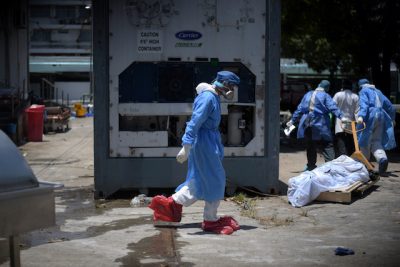Ecuadorian Humanitarian Catastrophe Amidst Pandemic

Among the countries affected by the global pandemic, it is undeniable that there is a certain imbalance in media coverage, with some very affected countries being scarcely followed by the news, while in other locations the situation is overestimated. An example of what is being said here is the case of Ecuador, about which little or nothing has been said in the mainstream mass media around the world. The collapsed South American country began the biggest crisis in its recent history. The fragile Ecuadorian public health structure was not efficient to deal with even the first cases of COVID-19, causing the infection to spread quickly. The government’s slowness in taking action to control the crisis was also a key factor in building the current scenario: Ecuador, in a very short time, became the country with the highest number of deaths per capita due to the new coronavirus in Latin America.
In order to be aware of the exponential growth of the infection in the country, Ecuador reported its first positive of new coronavirus on February 29 and, today, already confirms almost 3,700 cases and more than 180 deaths. However, these figures are far from representing the reality of the country’s infection. With the rapid expansion of the disease, the huge number of people in hospitals caused the national health system to collapse in a few days, generating such a situation that many people become ill and even die without ever going to a hospital, making it impossible to identify the actual number of patients in the country.
“It is a sum of several factors, but the main thing is that in Ecuador we have not strictly followed all the measures that must be taken to face an emergency of this magnitude, nor have people paid attention to government alerts,” said Esteban Ortiz, an Ecuadorian epidemiologist from the University of the Americas, in an interview with the BBC Spanish edition. The same researcher relates the emergence of the disease in Ecuador to the close ties between the country and Spain – with a constant flow of people – in addition to the failure in closing the airports and adopting the mandatory quarantine.
“[Patient zero] came from Spain and spent several days at her family’s house, participating in social gatherings, where he infected other people, including his sister, who also died due to the coronavirus in a few weeks (…) And there was, at that time, no strict control after his arrival (…) It is true that this [the delay in closing airports and adopting quarantine] is a factor that influenced the number of infections – although not the only one – especially in Guayaquil and Quito, where are the international airports and where most cases occurred,” said Ortiz.
However, in order to better understand the Ecuadorian crisis, we have to analyze it deeply, studying mainly the political turmoil in the country. Current President Lenín Moreno has recently become the West’s best bet for Ecuador. Moreno had previously been Vice President of Rafael Correa. Having ruled the country for a decade, Correa created the moment of greatest social and political stability in Ecuador, starting the process he called the “Citizen Revolution”, reducing poverty and increasing the country’s middle class. Moreno was, for a long time, his ally, but things changed completely in 2017, when the current president was elected, supported by Correa and his constituency in a sphere of “continuity” that was broken immediately after Moreno took office.
Moreno immediately started an internal coup in the party, allying himself with the neoliberal right and initiating a policy of scrapping and dismantling the entire legacy of Rafael Correa, approving measures of “economic austerity”, liberalization, privatizations and reducing the country’s social indexes. On the international stage, Moreno’s capitulation to the liberal hegemonic forces is even clearer, considering that it was he who betrayed Julian Assange, founder of WikiLeaks, handing him over to Interpol.
The result of Moreno’s neoliberal alignment has clear effects on the way the country deals with the pandemic. The arrival of the coronavirus in Ecuador was combined with a profound social factor: extreme mass poverty and scrapped public services. Within days, the failed Ecuadorian public health structure gave way to a massive demand for tests and treatments for the new coronavirus. With the immediate collapse, most of the Ecuadorian population is left to their own devices. Still, not even the funeral market is being effective in dealing with the demand for services, which, added to the impossibility of a good part of the poor population to pay the funeral costs, is generating a scenario of sanitary catastrophe, with bodies being abandoned or burned in the streets of the country’s popular neighborhoods.
With a good part of the population thrown into poverty and unable to pay for a test to discover if they are infected, how can we trust the official data? If the figures reported by the government are already alarming, in fact, the actual figures for COVID-19 in Ecuador must be even more catastrophic. All of this is the result of the liberalization and scrapping policies promoted by Moreno to encourage privatization and submission to the financial market. Now, who will help Ecuador? With practically the whole of South America facing serious problems of infection and the USA, Moreno’s main ally, being the country most affected by the disease in the world, Ecuador may be left alone with the catastrophe, paying the price of its own political, geopolitical and economic decisions.
*
Note to readers: please click the share buttons above or below. Forward this article to your email lists. Crosspost on your blog site, internet forums. etc.
This article was originally published on InfoBrics.
Lucas Leiroz is a research fellow in international law at the Federal University of Rio de Janeiro.
Featured image is from InfoBrics

